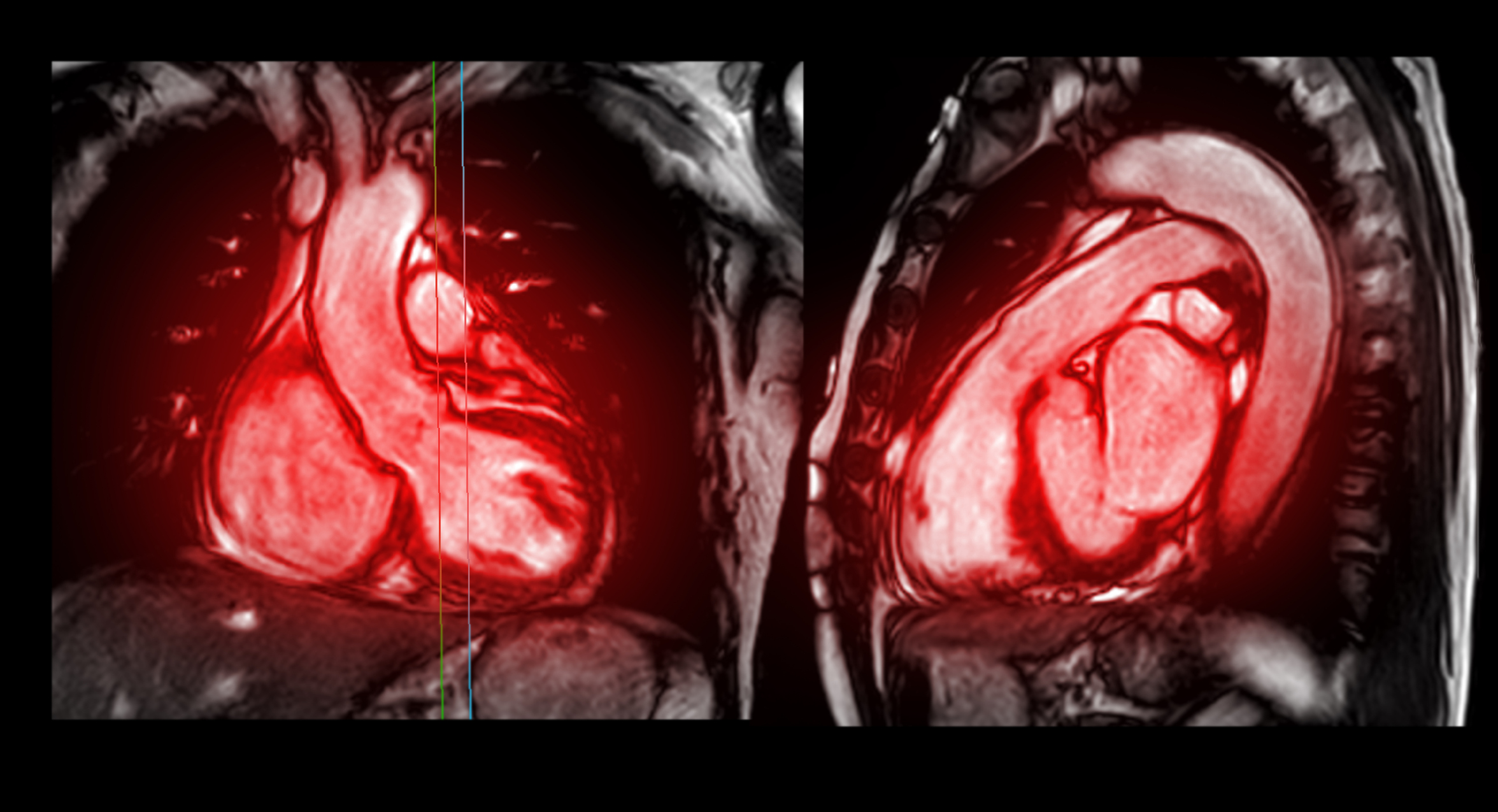Deep Learning Reconstruction for Cardiac Magnetic Resonance Fingerprinting
TECHNOLOGY NUMBER: 2020-513

OVERVIEW
Image reconstruction pipeline to display cardiac MRF maps in DICOM format at the scanner in 40 seconds- Pulse sequences for spiral trajectory measurement and cardiac MRF T1, T2, and M0 mapping (native and post-contrast)
- Image reconstruction software for cardiac MRF, including low-rank and Deep Image Prior methods
- Software for calculation of synthetic multi-contrast LGE images
BACKGROUND
Quantitative MRI is a powerful tool for assessing cardiac health. Two clinically measured tissue properties are T1 and T2, which can be used for early detection and monitoring of fibrosis, inflammation, and edema, among other conditions. Cardiac magnetic resonance fingerprinting (cMRF) is one technique for simultaneous T1-T2 mapping, which uses a time-varying sequence, an undersampled spiral k-space trajectory, and pattern matching with a dictionary of simulated signals to estimate quantitative maps.
Although the cMRF acquisition is efficient, with data collected during one breathhold, the reconstruction time is long and prohibits real-time display of the maps. One major hurdle is that the subject's cardiac rhythm determines the pulse sequence timings because the scan is electrocardiogram (ECG) triggered. As a result, a new dictionary must be simulated after every acquisition that appropriately models the scan timings to obtain accurate quantitative maps. A typical cMRF reconstruction uses a dictionary with over 20,000 T1-T2 entries and requires 5 minutes to calculate from a Bloch equation simulation (including corrections for slice profile and preparation pulse efficiency).
INNOVATION
In this work, University of Michigan researchers have developed an efficient cardiac MRF reconstruction pipeline for simultaneous T1, T2, and M0 mapping. The package provides:
- Spiral trajectory measurement and cardiac MRF pulse sequence files for Siemens XA scanner versions
- MATLAB code for processing cardiac MRF maps (both pre-contrast and post-contrast) using a low-rank reconstruction. Recommended MATLAB version 2023a or later on Windows or Linux.
- MATLAB code for calculating synthetic multi-contrast LGE images from post-contrast MRF T1 and T2 maps.
- Python code for reconstructing MRF T1, T2, and M0 maps with reduced noise and higher precision using a Deep Image Prior. Recommended running on Linux with a GPU.
Questions or Additional Information: Please contact Jesse Hamilton (hamiljes@med.umich.edu) or Nicole Seiberlich (nse@med.umich.edu).
OTHER
ACADEMIC AND RESEARCH EDUCATION USE LICENSE:
This license is for academic or research users only. Purchase of this license requires authorization. Please complete the authorization request form that appears after selecting the "Buy" button below. Requests must be made from a valid academic or research domain email address (.edu, .org or equivalent) and must include a description of the nature of your research in the notes section of the form. Failure to provide this information will result in the denial of your request. This license includes one digital file, available for download after the license agreement has been executed.
-
expand_more mode_edit Inventor (2)Jesse HamiltonNicole Seiberlich
-
expand_more library_books References (5)
- Hamilton JI, Jiang Y, Chen Y, Ma D, Lo WC, Griswold M, Seiberlich N. , MR fingerprinting for rapid quantification of myocardial T1,T2, and proton spin density. Magn Reson Med. 2017 Apr;77(4):1446-1458. doi: 10.1002/mrm.26216.
- HamiltonJI, Pahwa S, Adedigba J, Frankel S, O'Connor G, Thomas R, Walker JR, Killinc O, Lo WC, Batesole J, Margevicius S, Griswold M, Rajagopalan S, Gulani V, Seiberlich N. , Simultaneous Mapping of T1 and T2 Using Cardiac Magnetic Resonance Fingerprinting in a Cohort of Healthy Subjects at 1.5T. J Magn Reson Imaging. 2020 Oct;52(4):1044-1052. doi: 10.1002/jmri.27155.
- Hamilton JI, Seiberlich N. , Machine Learning for Rapid Magnetic Resonance Fingerprinting Tissue Property Quantification. Proc IEEE Inst Electr Electron Eng. 2020 Jan;108(1):69-85. doi: 10.1109/JPROC.2019.2936998.
- Hamilton JI , A Self-Supervised Deep Learning Reconstruction for Shortening the Breathhold and Acquisition Window in Cardiac Magnetic Resonance Fingerprinting. Front Cardiovasc Med. 2022 Jun 23;9:928546. doi: 10.3389/fcvm.2022.928546.
- Rashid I, Al-Kindi S, Rajagopalan V, Walker J, Rajagopalan S, Seiberlich N, Hamilton JI , Synthetic multi-contrast late gadolinium enhancement imaging using post-contrast magnetic resonance fingerprinting. NMR Biomed. 2024 Jan;37(1):e5043. doi: 10.1002/nbm.5043
-
expand_more cloud_download Supporting documents (1)Product brochureDeep Learning Reconstruction for Cardiac Magnetic Resonance Fingerprinting.pdfAdditional files may be available once you've completed the transaction for this product. If you've already done so, please log into your account and visit My account / Downloads section to view them.